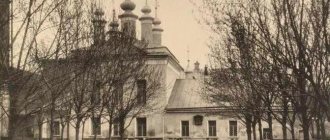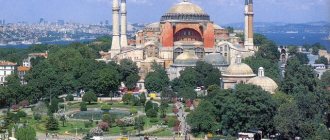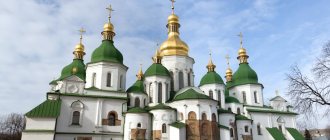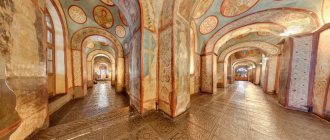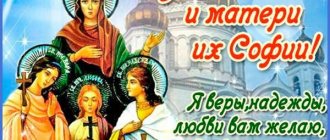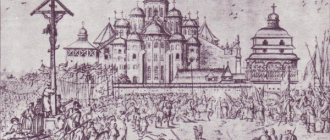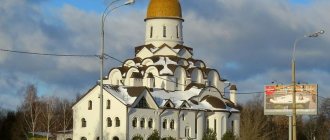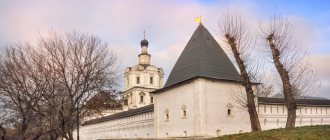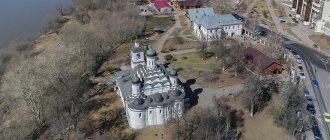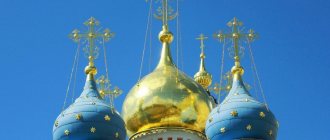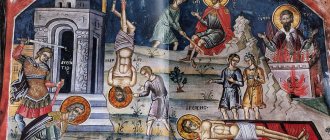- Ukraine
Hagia Sophia (St. Sophia Cathedral) is a temple built in the first half of the 11th century in the center of Kyiv, according to the chronicle, by Prince Yaroslav the Wise at the site of the victory in 1037 over the Pechenegs. At the turn of the 17th–18th centuries, it was externally rebuilt in the Ukrainian Baroque style. Inside the cathedral, the world's most complete ensemble of original mosaics (260 m²) and frescoes (3000 m²) from the first half of the 11th century and significant fragments of murals from the 17th–18th centuries have been preserved. During Soviet times, it was an active temple until 1929, and in 1934 it became a museum - the Sofia Reserve. Nowadays it is the core of the National Reserve "Sofia of Kiev", one of the largest museum centers in Ukraine, which also includes the Golden Gate of the 11th century, the St. Cyril Church of the 12th century. and St. Andrew's Church of the 18th century. in Kyiv.
In 1990, the St. Sophia Cathedral, like the Kiev Pechersk Lavra, became the first architectural monument on the territory of Ukraine to be included in the UNESCO World Heritage List.
History of creation
The order to build the cathedral was given by Yaroslav the Wise in the 11th century. One version says that the construction of the temple was connected with the arrival of Metropolitan Theopemptos to the city - the future primate of the Russian church, a Greek, was moving from Constantinople.
Initially, the cathedral was a 13-domed structure, to which 6 more chapters were added several centuries later. And by the 17th century, the building was reconstructed in the Ukrainian Baroque style.
Over the course of ten centuries of its existence, the cathedral was repeatedly attacked by invaders. In the 13th century, it survived the invasion of Batu - his hordes destroyed almost the entire building and carried away precious utensils. Two centuries later, the temple was plundered by the Crimean Tatars, who killed the Metropolitan of Kyiv, Saint Macarius.
In the 14th century, the Uniates already finished off the cathedral. By this time, services had already ceased in the temple, and the building itself was kept, as they say, on its word of honor. A key role in the restoration of the cathedral was played by Metropolitan Peter, who in 1633 attracted the Italian architect Octaviano Mancini to the work. The end of the 17th century was the time of the final return of the St. Sophia Cathedral, when icons and frescoes were restored, and the building itself acquired pear-shaped domes and walls decorated with stucco.
20th century and modern times
The October Revolution directly influenced the St. Sophia Cathedral. Until 1917, it remained the cathedral of the Metropolitans of Kyiv and Galicia, and with the advent of the Soviet regime, a real struggle for power began here - which of the metropolitans could call themselves real. A split in the church could lead to a split in society, so they decided to quickly close the cathedral and turn it into a museum-reserve. In 1934, the St. Sophia Museum was declared a State Architectural and Historical Reserve, which first included, in addition to the St. Sophia Cathedral, the bell tower, and later - the remaining architectural monuments of the 18th century, which formed the architectural ensemble of the St. Sophia Monastery: the southern entrance tower (early 18th century), built in 1722 –1730 refectory, bakery (bakery, later - consistory) and the Metropolitan's House, finally, the Zaborovsky gate (1731–1745), the fraternal building (cells) (mid-18th century) and the bursa (1763–1767).
Major restoration work was carried out in the cathedral, revealing a grandiose integral ensemble of mosaics and frescoes of the second decade of the 11th century. In 1987, the international jury of the Hamburg Alfred Töpfer Foundation awarded the cathedral the European Gold Medal for the preservation of historical monuments. Included on the World Heritage List in 1990.
Useful tips for visitors
There are regular tours of the temple, which can be useful for those who want to study the architecture and history of the cathedral.
For people who want to pray at the relics of the saints located here, it is best to come on weekdays, when there are fewer people in the temple than on holidays and weekends.
How to get to the cathedral?
You can get to the shrine by any public transport that goes to the Novgorod Kremlin. In addition, visiting it is usually included in tourist excursions around the city.
Architecture of Sophia of Kyiv, necropolis
St. Sophia Cathedral is built of rubble stone and plinth. Rows of stone and plinth alternate. The arches and vaults were built without stone. The cementing substance is lime mortar mixed with sand and cement (crushed brick). Ceramic jugs-voices are built into the walls of the cathedral in the upper part. Thus, the construction of the walls was lightened and the acoustics in the temple premises were improved.
Initially, Sofia had five apses and five domes. Its walls were plastered. From the west and north the temple was surrounded by open galleries.
Sofia was built in the Byzantine style, but initially it was not similar to other Byzantine churches, and after reconstruction and additions it turned into a completely original, unique architectural masterpiece.
The current dimensions of the cathedral are as follows: length 37, width 55, height 29 meters. It has two floors and nine apses. The cathedral is crowned with 19 domes, of which 8 have an ancient spherical shape, and 11 have a baroque pear-shaped shape.
The interior of the temple has been preserved since the 11th century, with the exception of certain parts. From the same time, 3000 sq. m. have been preserved. meters of frescoes and 260 sq. meters of mosaic. The mosaics of the temple, which use 177 shades of colors, are of great value. This is especially true of the six-meter image of the Virgin Mary Oranta (the one who prays), which has survived to this day with virtually no restoration work. The wall on which the image is located is called the “Unbreakable Wall”, because it remained absolutely intact even in the worst times for Sofia. None of the invaders who captured Kyiv at different times raised their hands against Oranta. One can only imagine the surprise of travelers who entered the dilapidated cathedral and saw this majestic mosaic in front of them.
Recently, another unique mosaic was placed on the second floor of the cathedral - the panel “Looking into Eternity”, made from 15 thousand Easter eggs.
Necropolis
The necropolis of St. Sophia of Kyiv is of great value for the Ukrainian people, the oldest burial of which is the sarcophagus of Yaroslav the Wise. Today, there is no consensus among scientists regarding the origin of the sarcophagus and its age. According to one of the main hypotheses, the sarcophagus was made in Chersonesos in the 9th century. The relics of the Great Martyr Clement of Rome were going to be buried there. The sarcophagus was brought to Kyiv by Vladimir the Great, and in 1054 it became the tomb of Yaroslav. The weight of the sarcophagus is 6 tons.
The sarcophagus of Yaroslav the Wise was opened several times. At first this was done back in Russian times. Apparently it was then that a skeleton was placed next to Yaroslav
an unknown woman about 50 years old and a male skull (instead of a female one). At the same time, the tomb was robbed (there is nothing in the sarcophagus except bones).
The sarcophagus was opened for scientific research four times: in 1936, 1939, 1964 and 2009. Scientific research has almost proven that the male skeleton belongs to Yaroslav the Wise. Now he is not in the tomb - the body of the Grand Duke is being examined.
In addition to Yaroslav, the Metropolitans of Kiev are buried in the St. Sophia Cathedral: Cyril II (1282), St. Macarius (1497), Sylvester Kosov (1657), Gideon Chetvertinsky (1690), Rafail Zaborovsky (1747), etc. The refectory contains the sarcophagus-tomb of Princess Olga, which was moved from the Church of the Tithes.
Architectural features of St. Sophia Cathedral
St. Sophia Cathedral, built during the heyday of Constantinople, became one of the most significant Orthodox churches in the history of temple construction. This was facilitated by its geographical location in the capital of the Byzantine Empire and its unique architectural and artistic design, which made it a masterpiece in temple construction of that period.
According to historical reconstruction, St. Sophia Cathedral originally looked like this
The St. Sophia Cathedral of Constantinople is a striking example of the transition from basilica temple construction to cross-domed construction. On one side, the plan of the cathedral looks like a rectangular quadrangle (76x68) with three naves, slightly elongated, as befits a basilica. On the other hand, its middle, wider nave is a square cross, above which is a 30-diameter dome.
The low central dome, 50 meters high from the floor, consists of 40 radial arches based on a solid foundation created by four massive pillars and huge arches. At the bottom of the dome, between the arches, there are windows that visually form a single light belt. In addition to these windows, the temple is also illuminated by the windows of large and small niches. Spherical triangles, the so-called sails, connecting the dome with a rectangular volume, later began to be successfully used in architecture.
Although the dome of the cathedral has been redone several times, it makes a strong impression
The space under the dome has been significantly expanded due to the adjacent rather voluminous niches (western and eastern) with their own semi-dome endings. Further, the general space of the temple is expanded by smaller niches, three on each side. The eastern niche of the main volume is continued by niches, one of which (the central one) is the altar part of the temple. In the general plan of the temple, it stands out as a protruding semicircle of the apse. The central niche of the three adjacent to the western niche is designed not in the form of a semicircle, but in the form of a rectangular box with three doors leading to the vestibules.
The arches of the side naves on the southern and northern sides are decorated with beautiful columns made of porphyry and malachite. They were brought specially from temple buildings in Egypt and Asia Minor. Behind these columns there are gallery spaces. Interestingly, in the center of the cathedral a place was designated, which is a symbol of the center of the Byzantine Empire. All Byzantine emperors were later crowned here.
The site of the center of the empire and the coronation of the Byzantine emperors is available for viewing
There are also mystical places in the cathedral in the form of a copper “weeping column”, which supposedly grants wishes and brings healing, and a cool window through which coolness blows at any time of the year and a mysterious noise is heard.
The interior of the temple, reflecting the main traditions of Byzantine art, such as grandeur, pomp, and solemnity, was improved even after construction was completed. Especially after the end of the period of iconoclasm. The walls were covered with subject mosaic paintings. To this day, mosaics from the 9th to 14th centuries with images of seraphim, archangels, the Mother of God and the Child Jesus, some prophets and saints, Byzantine emperors, etc. have been preserved.
Byzantine mosaic art of the cathedral
Walking around the St. Sophia Cathedral, you can see Christian and Muslim elements of its decorative decoration. Christian mosaics primarily include Byzantine mosaics, partially preserved on walls, vaults, sails, etc. From them you can trace how the art of Byzantine mosaic improved from the 9th century to the 14th century. All of them were created after the end of the period of iconoclasm, during which the original design of the temple was destroyed.
The paintings of the St. Sophia Cathedral, dating back to ancient times, evoke awe
Of constant interest is the mosaic canvas above the entrance of the narthex, which depicts the blessing of Emperor Leo the Sixth by Jesus (9th century). Christ himself is depicted sitting on a throne, the emperor is kneeling in front of him on the left, and in the medallions located on both sides of Jesus you can see images of the Archangel Michael and the Virgin Mary.
Also on one of the pillars of the upper gallery there is a unique lifetime mosaic image of Emperor Alexander III at the Easter service (early 10th century). And the mosaic painting of the Mother of God in the over-door arch of the southern vestibule dates back to the end of the 10th century. Here, next to the Mother of God, you can see the emperors Constantine (right) and Justinian (left), who present her with valuable gifts in the form of the city of Constantinople and St. Sophia Cathedral. This is perhaps the only work of art of ancient Byzantium where both of these emperors are depicted together.
The image of the Mother of God with Constantine and Justinian is truly unique
Later mosaic paintings of the St. Sophia Temple (11th century) are the image of Constantine the Ninth and his wife Zoe presenting gifts to Jesus and a mosaic with the Virgin Mary and the upcoming emperor John the Second and his wife Irina (12th century), which are on the walls of the upper southern gallery.
Constantine the Ninth and his wife Zoe next to Jesus. This is a mosaic from the 11th century
There you can also find the remains of a Deesis mosaic dating back to the 13th century, which shows a very artistic and spiritually rich image of Jesus with the Virgin Mary and John the Baptist.
Little has survived from the Deesis mosaic, but the skill of this art is amazing
The most noticeable mosaic images for tourists in the main hall are the figures of seraphim located in the triangles of the eastern sails. These images have only become available for inspection since 2009.
Muslim architectural elements in the cathedral
The fact that from the 15th century the St. Sophia Cathedral was used as a Muslim mosque could not but affect its architectural appearance and interior design. The attached minarets have already been mentioned above. But this concerned external changes. For Muslim services, it was necessary to equip a mihrab (a place showing the direction of prayer) and a minbar (a platform for the imam). But the fact is that the Orthodox altar of the St. Sophia Cathedral was located on the eastern side of the temple, and the mihrab should have been located to the southeast, i.e. to Mecca, which was done. Thus, the worshipers were located at a slight angle to the center of the main volume of the room.
The Muslim mihrab is located in the former Orthodox altar
Tall and beautiful carved minbar
made of marble appeared in the temple during the reign of Murad the Third towards the end of the 16th century. And the mihrab in the altar was built during the reconstruction of the cathedral in the mid-18th century by Sultan Mahmud the First. The mihrab that today's tourists see is its later restoration (mid-19th century). On both sides of the mihrab there are rare candlesticks made of bronze, which Suleiman the Magnificent himself brought to Istanbul from Buda he conquered.
The tall carved minbar to the right of the mihrab appeared in the temple in the 16th century
In addition, in the interior of the temple there are 8-meter shields with suras from the Koran. Surahs from the Koran also decorate the dome, covering the earlier image of Jesus there. Arabic script also decorates stained glass windows.
The stained glass windows in the temple are made
in the traditional Muslim style
. In addition to Christian and Muslim signs and symbols, in the temple you can find traces of Kievan Rus in the form of Slavic graffiti of the 11th-15th centuries, as well as traces of the Scandinavian Varangians in the form of Runic inscriptions. Both of them are analogous to modern inscriptions “so-and-so was here.”
The galleries of the cathedral are equipped with reading rooms for reading religious books.
You can visit this unique architectural and historical monument of Istanbul, which is located on Sultanahmed Square, completely independently and free of charge, but only during hours not occupied by namaz (prayer). When visiting, there are certain dress code requirements: all visitors must remove their shoes, and women must cover their heads and shoulders with scarves.
With a leisurely and detailed acquaintance with the temple, you can touch the amazing antiquity
St. Sophia Church is open daily from 9 am. It closes at 17:00 in winter, and at 18:00 in summer.
Author of the article: Kasatkina Tatyana
Mosaics and Frescoes of St. Sophia of Kyiv
The Cathedral of St. Sophia of Kiev, founded in 1037 by the Grand Duke of Kyiv Yaroslav the Wise, has preserved to this day not only the wealth of ancient architecture, but also the picturesque decoration of the 11th century. Sophia of Kyiv harmoniously combines two types of monumental painting - mosaics and frescoes. Mosaics highlight the main parts of the interior - the central dome and the altar. The rest of the five-nave space, the second floors (“polati”, or choirs), both staircases and open galleries that surrounded the Temple of St. Sophia of Kyiv in ancient times were decorated with frescoes. 260 square meters of original mosaics from the 11th century and about three thousand square meters of fresco painting have survived to this day.
The painting system, the choice of subjects and the placement of images are subordinated to a clear ideological plan, arising from the purpose of the St. Sophia Cathedral of Kiev as the main temple of the Old Russian feudal state. Dedicated to Sophia as a symbol of wisdom, the Kiev Cathedral of St. Sophia, its architecture and painting were, according to the plans of the customers, to affirm and strengthen the Christian faith, and with it feudal power. Religious and state ideas that were so important for that time were embodied in the artistic image of Sophia of Kyiv and, like a leitmotif, pass through the entire system of her pictorial decoration. In the paintings, secular and religious principles are closely intertwined, merging into a solemn hymn to the power of the Old Russian state and its glory.
In the central dome and altar of the Cathedral of St. Sophia of Kyiv there are images of the main characters and scenes of Christian doctrine. They are made using the mosaic technique, that is, they are assembled onto wet plaster from small cubes of glassy mass - smalt. A shimmering gold mosaic background enhances the vibrant, rich tones of the images. The mosaics of St. Sophia of Kyiv have 177 color shades. Unfortunately, history has not preserved the names of the artists who perfectly mastered this rich palette.
At the zenith of the central dome of Hagia Sophia of Kyiv, in the medallion, is a huge half-length image of Christ the Pantocrator. Four archangels were located around the medallion. Only one mosaic figure in a blue robe has survived, and the other three were added in oil in 1884 by M. A. Vrubel.
A wonderful ensemble of mosaics adorns the main altar of the Church of St. Sophia of Kyiv. The gaze of those entering the cathedral is drawn by the majestic monumental figure of the praying Mother of God - Oranta (the wisdom of God), placed in the vault of the altar. The combination of the blue color of her robe and the warm golden background is the main principle of the coloristic design of the picturesque decoration of the cathedral.
The decoration of the main altar of the Cathedral of St. Sophia of Kiev is a high example of the synthesis of architecture and painting, which is generally characteristic of the entire ancient interior of St. Sophia of Kyiv. Scenes and characters in mosaics are symbols that reveal the main provisions of Christian doctrine. They are perceived as a kind of epigraph to the subsequent pictorial story, presented using the fresco technique, that is, painted with water paints on wet plaster. On the scenes of the transept (the main transverse division of the temple) there are Gospel scenes of a narrative nature, of which the best preserved are “The Crucifixion”, “The Descent of Christ into Hell”, “The Appearance of Christ to the Myrrh-Bearing Women”, as well as the scene “The Descent of the Holy Spirit”, remarkable for its composition, unique style of writing and soft color scheme.
Frescoes
Frescoes in the towers of St. Sophia Cathedral are an interesting source of information about the life of the princely court, about various aspects of life of that time. They are the only surviving collection of everyday monumental painting from the times of the Old Russian state of Kievan Rus.
A significant place in the picturesque decoration of the Temple of St. Sophia of Kiev is occupied by ornaments that decorate window and doorways, frame individual fresco and mosaic compositions, and emphasize the main architectural lines of the interior. Most often they are of a plant nature and consist of stylized palmettes, vine shoots, curls and buds. Geometric ornamental structures are less common. Elegant and colorful, the ornaments also introduce a secular element into the general system of paintings of Sophia of Kyiv.
Mosaics and frescoes of the Cathedral of St. Sophia of Kiev meet the high requirements of monumental art. They are characterized by an organic connection with architecture, clarity and conciseness of artistic language, deep emotionality of images, compositional and coloristic integrity, and breadth of artistic thinking. The achievements of Kyiv monumentalists were carefully preserved by ancient Russian artists of subsequent generations. The best traditions of the picturesque decoration of the St. Sophia Cathedral live in the works of Andrei Rublev and Dionysius, in the frescoes of Novgorod and Pskov, in ancient Ukrainian icons, in the picturesque ensembles of the Moscow Kremlin, in the paintings of wooden churches in Ukraine.
The Legend of the Stone Pigeon
Many legends and epics have been collected around the ancient cathedral. Some of them have documented information. One of these is the legend of the stone dove.
On the cross of the central dome there is a lead figure of a dove - a symbol of the Holy Spirit. According to legend, when Ivan the Terrible brutally dealt with the residents of Novgorod in 1570, a dove sat down to rest on the cross of Sophia. Seeing the terrible massacre from there, the dove was petrified with horror.
According to legend, Ivan the Terrible treated the Novgorod people savagely and undeservedly. Then an ordinary live dove landed on the cross of the cathedral. He looked down and, seeing the ugly sight, turned to stone. Then one of the clergy had a vision that the bird had flown into the city as a consolation, and while it was on the cross, the city was being protected by angels from heaven.
Important to know: official information about Hagia Sophia can be found on the website https://saintsofianovg.ru.
Graffiti of Sofia of Kyiv
Sophia of Kiev is known mainly for its paintings and mosaics; it is known a little less as a source of paleographic inscriptions. It often happens that visitors to an ancient cathedral look at the faces of saints on the wall, but do not notice the inscriptions located at the level of their own nose. And it would be worth doing, because you can discover a lot of interesting things. St. Sophia of Kiev as a Russian metropolitanate (literally “mother of Russian cities”) attracted a lot of pilgrims, and many of them left autographs in memory of their visit to the shrine.
Such inscriptions are called the Italian word “graffiti” (with the emphasis on the second syllable, plural; in the singular - “graffito”).
Prayer calls and exclamations of repentance are an important theme of Sofia inscriptions. And indeed, there are quite a lot of them: “Lord, help Your servant George,” “Lord, help Your servant Grigorevi. Amen", "Lord, help your servant
John the sinner, like this writer. Amen,” “Michael is poor, but rich in sin, he wrote, Lord, help him,” there is also Vasily himself: “Lord, help Your servant Vasily, help him, a sinner...”
Such inscriptions can be perceived as a kind of “eternal” commemoration, because books and papers can burn, and the walls of St. Sophia of Kiev still contain requests for the prayers of our distant ancestors... But among such prayers one can also find a laconic anonymous repentant message: “Fornication committed in holy day".
However, the ancient Russian parishioners of St. Sophia Cathedral prayed not only for themselves. In the window opening of the southern gallery, a loyal subject inscribed: “Help, Lord, our kagan.” Kagan is an ancient Turkic title, analogous to a king or prince. For example, the Khazar kings were called kagans. The title was also in circulation in Rus'. Saint Hilarion of Kiev in his “Sermon on Law and Grace” (1030–1050) calls the great princes Vladimir and Yaroslav kagans: “About the law given by Moses, and about the grace and truth that was given by Jesus Christ. And when the law departed, grace and truth filled the whole earth, and faith in all languages extended even to our Russian language. And praise to our Khagan Vlodimir, for it was worthless to be baptized,” “But in the summer of 6559, the ruling noble Khagan Yaroslav, son of Vladimir.”
Much less often, other princes are called kagans, i.e., kings, in ancient Russian writing. The author of “The Tale of Igor’s Campaign” recalls the past “Kagan time” - the time of the power of Kievan Rus before the era of civil strife.
Church of the Intercession on the Nerl (Bogolyubovo)
Address: Vladimir region, Suzdal district, Bogolyubovo village, st. Vokzalnaya 10.
Date of construction: 1166.
The snow-white building, surrounded by water on all sides, resembles foreign architecture, thanks to the Romanesque style. The church looks like a quadrangular structure covered with a belt of false arches.
Today it is a functioning temple that welcomes parishioners at any time.
Unknown Sofia: 7 interesting facts
- The bell tower of St. Sophia Cathedral was built by Hetman Ivan Mazepa. Its height is 76 m. It still houses the large bell “Mazepa”, cast by the Kyiv master Afanasy Petrovich in 1705 by order and at the expense of the hetman. The weight of the bell is 13 tons, height – 1.25 meters. The bell is covered with magnificent ornaments and the coat of arms of Hetman Mazepa is cast on it.
- Until now, scientists do not know where the library of Yaroslav the Wise , which was allegedly located in the basements of the St. Sophia Cathedral. It was never found during any of the excavations. The only mention of it dates back to 1037 in the Tale of Bygone Years, written by Nestor the Chronicler. It is believed that there were about a thousand books in it. Perhaps they are hidden in the Kiev Pechersk Lavra.
- In the St. Sophia Cathedral there is one of the famous and rare mosaic images of Oranta - the Mother of God with her arms raised in prayer and outstretched to the sides. It is also called the Unbreakable Wall. Oranta is distinguished from other images of the Mother of God by its majesty and monumentality. But the main thing is that she is extremely rarely depicted without a baby.
- The cathedral preserves the largest collection of frescoes (3 thousand sq. m) and mosaics (260 sq. m) from the 11th century. Most graffiti has religious content. Basically these are prayers asking for mercy on this or that person. On one of the walls there is an inscription made by Prince Bryacheslav. He asks the Lord to help him, “sinful and wretched.”
- In 2008, Sofia was returned to the iconostasis - the Royal Doors - an openwork lattice with images of saints. They were made in 1747–1750 by Kyiv craftsmen. But in the 30s of the last century, the Soviet government decided to send the Gate for melting down. Only 11 fragments remain. Based on them and the surviving drawings, the shrine was restored. They took 104 kg of silver.
- Experts find in “Sofia” not only prayers, but also inscriptions of a secular nature. For example, on one of the walls an unknown author wrote: “Kozma thief (thief) stole meat. Aspen on your head. Amen!" There is graffiti, not without humor: “While learning to read and write, Thomas the eunuch wrote this.” The entry has been crossed out several times. Perhaps Thomas himself did this.
- During the construction of the cathedral in Kiev, a new tax : everyone who entered the city on a cart had to bring with them several stones. As historians say, outwardly Sofia was stern and majestic, but inside it amazed with the gold of its mosaics and the luxurious colors of its frescoes. Already in those distant times, Sophia of Kiev was considered a true architectural masterpiece.
Magdeburg Gate
Figure 3. Magdeburg Gate
These metal doors are one of the attractions of this place. Exactly when they appeared here and what their origin was is not known for certain.
Important! The first mention of this gate dates back to the 16th century. In documents of that time they are most often called German. The gates were first called Magdeburg only at the end of the century before last.
Tsarevich Dmitry - Church on the Blood
Address: Uglich, st. Kremlin, 3
Date of construction: 1692.
The building on the banks of the Volga is a cultural heritage site of Russia and is also included in the UNESCO list. The temple was built on the site of the death of Tsarevich Dmitry. But at first it was a log house for a chapel, which was destroyed by the Poles, then a wooden church, and only in 1692 one of the most beautiful churches in Russia “grew” on this site.
The temple looks spectacular from any side, but is especially beautiful from the south. Huge windows are decorated with large white frames. The red walls seem to remind of a distant tragedy.
